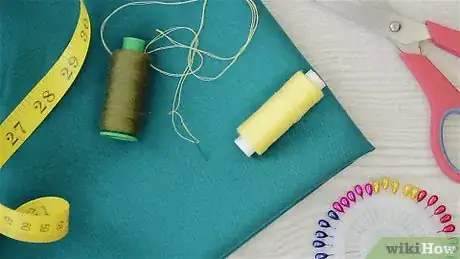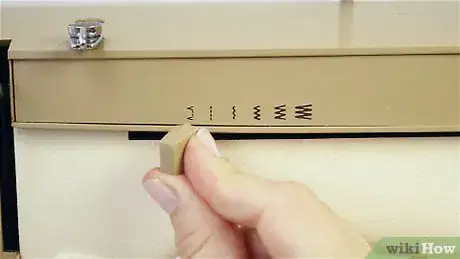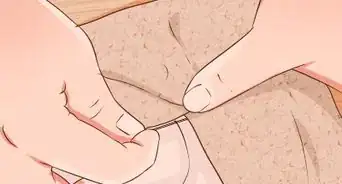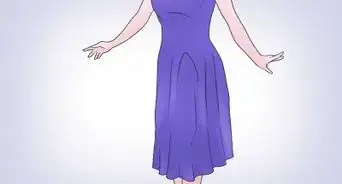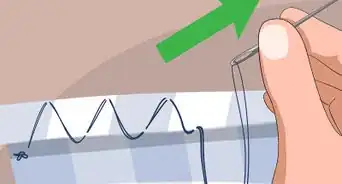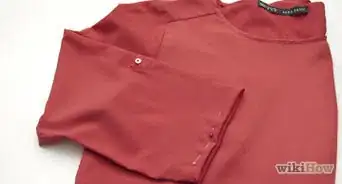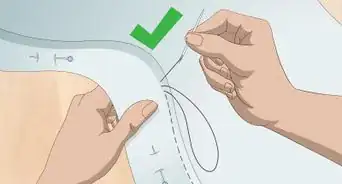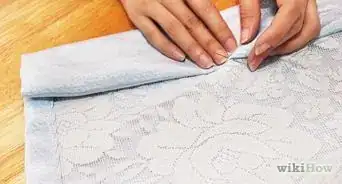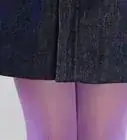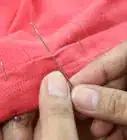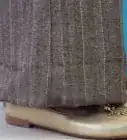This article was co-authored by David Pew. David Pew is a Professional Tailor and the Owner of Sew Generously based in Seattle, Washington. With over a decade of experience, David specializes in bespoke tailoring and alterations. He uses his experiences, skills, and eye for detail to produce the highest quality of products.
This article has been viewed 194,201 times.
Unless you have an unlimited clothing budget that allows you to discard clothing as soon as it needs mending, at some point you may need to repair or hem an article of clothing. Hemming gives fabric a finished, clean edge and helps clothes last longer by preventing unraveling. There are several ways to sew a hem depending on what you want the finished look to appear like, but the double-fold hem and blind stitch hem are most common. Although neither is difficult, they both take a bit of practice to master.
Steps
Sewing a Double Fold Hem
-
1Decide how you will sew your hem. There are two ways to sew a hem: by hand or with a sewing machine. While the latter is obviously faster, the former allows you to sew a hem without many tools. If you can, set up your sewing machine for your hem; use a straight stitch for a double-fold hem.[1]
-
2Fold your hem. Lay out your clothing on a countertop pattern-side down, with the hem/edge in front of you. Fold the fabric edge up ⅝-inch, and use an iron to flatten it out. Then, starting from the edge, create a second fold over the first ⅝-inch wide, so that the raw edge of the first fold is hidden under the second fold.[2]
- ⅝-inch is the standard seam allowance, but you can use whatever measurement you want for your hem.
- If you're hemming a pair of pants that are tapered, be sure to account for that—you'll need to taper the inside piece outward so the pants don't pucker.[3]
Advertisement -
3Pin the hem in place. Use multiple straight pins to secure this fold. Insert the pins so that the blunt end (often with a pearl) sticks out from the hem, while the needle-end of the pin is inserted towards the fabric. This will make them much easier to remove as you sew (if you’re using a sewing machine).[4]
-
4Sew your hem. Either with your sewing machine or by hand, use a matching thread to your fabric and sew a straight stitch along the top edge of the fold. Work all the way around until you’ve sewn the whole hem, and then tie off and cut your thread.[5]
-
5Iron the hem. You’re almost done! To finish off your hem, you need to iron it so it lays down flat. If your fabric can handle it, use a bit of steam to help with the ironing process. When you’re done ironing, turn your fabric right-side-out, and enjoy your newly completed hem.[8]
Sewing a Blind Hem
-
1Determine if you have the necessary tools. Although you can hand-sew a blind hem, it can be very difficult and the process is much easier on a sewing machine. In order to sew a blind hem on a sewing machine, you must have two tools: a blind hem foot, and the proper stitch. A blind hem foot can be purchased at most sewing shops for around $10. In addition, check to see if your sewing machine comes with a stitch that looks like this: ^----^----^.[9]
-
2Prepare your fabric. If you haven’t already, prewash your fabric to prevent it from shrinking later. Then, place your fabric on a countertop with the pattern side down.[10]
-
3Fold your hem. Determine your seam allowance, as this is the width of the fold you will be making; a traditional seam allowance is ⅝-inch. Fold this much of the fabric up from the edge, and then do it again. This will hide the raw edge under fold, so that it won’t be seen in the finished hem. Use an iron to flatten this fabric out.[11]
-
4Pin the hem in place. Use a series of straight pins to hold the fabric in place. Insert the pins so that the blunt/pearl end is on the fabric portion, while the needle/tip is sticking out towards the edge of the hem.
- If you are using a sewing machine, fold your ironed section under the fabric. Take the portion of fabric that you just folded/ironed, and fold it in the opposite direction so that it is hidden under the fabric. However, fold it so that about ⅛ of an inch is exposed. Your piece of fabric should now have the pattern-side down, but the tiny ⅛-inch exposed fold at the edge will show the fabric.
-
5Sew the hem.
- For hand sewing, start at the edge of your fold. Just above the fold, pick up a very small portion of the fabric. Then go left about 1/4 in and pick up a bit of the fold. Right above that, pick up a very small portion of the fabric again. Continue in this manner until you reach the end of your hem.
- For a sewing machine, change your stitch to the one that looks like ‘--^----^--’. Turn your fabric sideways on the sewing machine, so that the ⅛-inch fold is on the right side, and the rest of the fabric is on the left. Begin sewing down the edge where the fold and the rest of the fabric meet. You should keep the edge of the fabric plumb to the divider on your presser foot. Sew like this all the way down the hem, until you reach the end of your fabric. You should notice that the ‘^’ stitches will hook onto the body of the fabric, while the regular straight stitches in between remain on the ⅛-inch folded portion.
-
6Finish your hem. Tie and cut off the excess thread, and then unfold your hem. On one side (the back) you should see the hem sewn with the ‘--^----^--’ pattern. However, on the other side the stitch should be ‘blind’, as in you’ll only see a tiny dot where the ‘^’ stitch hooked onto the fabric. If this is the case, use an iron to flatten out the hem, and complete your sewing project.[12]
Expert Q&A
Did you know you can get expert answers for this article?
Unlock expert answers by supporting wikiHow
-
QuestionShould I make hem stitches loose or tight?
 David PewDavid Pew is a Professional Tailor and the Owner of Sew Generously based in Seattle, Washington. With over a decade of experience, David specializes in bespoke tailoring and alterations. He uses his experiences, skills, and eye for detail to produce the highest quality of products.
David PewDavid Pew is a Professional Tailor and the Owner of Sew Generously based in Seattle, Washington. With over a decade of experience, David specializes in bespoke tailoring and alterations. He uses his experiences, skills, and eye for detail to produce the highest quality of products.
Professional Tailor
-
QuestionWhat is the best stitch for hemming?
 David PewDavid Pew is a Professional Tailor and the Owner of Sew Generously based in Seattle, Washington. With over a decade of experience, David specializes in bespoke tailoring and alterations. He uses his experiences, skills, and eye for detail to produce the highest quality of products.
David PewDavid Pew is a Professional Tailor and the Owner of Sew Generously based in Seattle, Washington. With over a decade of experience, David specializes in bespoke tailoring and alterations. He uses his experiences, skills, and eye for detail to produce the highest quality of products.
Professional Tailor
-
QuestionShould I hem all the sides of a piece of fabric?
 T. ChinsenTop AnswererAll sides of a hem need to be sewn on a garment. Not sewing all the way around can cause the hem to fall out and get caught or snagged.
T. ChinsenTop AnswererAll sides of a hem need to be sewn on a garment. Not sewing all the way around can cause the hem to fall out and get caught or snagged.
Warnings
- Don't use a needle that is too thick for the type of fabric you are hemming. A needle that is too large can damage your fabric by making holes that are too big. This will result in a visible hem.⧼thumbs_response⧽
References
- ↑ https://thesewingloftblog.com/double-fold-hem/
- ↑ https://www.thesewingdirectory.co.uk/double-fold-hem-tutorial/
- ↑ David Pew. Professional Tailor. Expert Interview. 5 January 2021.
- ↑ https://www.thesewingdirectory.co.uk/double-fold-hem-tutorial/
- ↑ https://www.loveyourclothes.org.uk/sites/default/files/articles/Fast%20Fixes%202%20-%20Machine%20hemming%20%28low%20res%29.pdf
- ↑ David Pew. Professional Tailor. Expert Interview. 5 January 2021.
- ↑ David Pew. Professional Tailor. Expert Interview. 5 January 2021.
- ↑ https://www.loveyourclothes.org.uk/sites/default/files/articles/Fast%20Fixes%202%20-%20Machine%20hemming%20%28low%20res%29.pdf
- ↑ https://blog.colettehq.com/tutorials/tutorial-how-to-sew-a-blind-hem
About This Article
There are several ways to sew a hem, but the double-fold hem and the blind stitch hem are the most common. For a double-fold hem, lay your clothing out and fold the fabric edge up ⅝-inch. Create a second fold over the first ⅝-inch wide so the raw edge of the first fold is hidden under the second fold. Pin the hem in place, then sew it by hand or with your sewing machine. To finish off the hem, iron it so it lays down flat. To learn how to sew a blind hem, keep reading!
